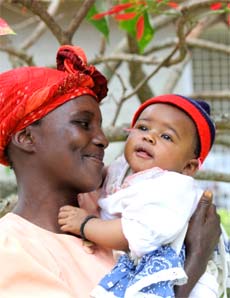fitness news
![]() ,
,![]()
Font size Women’s Health
Effectiveness of a Prevention of Mother-to-Child HIV Transmission Programme in an Urban Hospital in Angola
– Reported, 19 January 2013
 Antiretroviral therapy is effective in reducing rates of mother-to child transmission of HIV to low levels in resource-limited contexts but the applicability and efficacy of these programs in the field are scarcely known. In order to explore such issues, we performed a descriptive study on retrospective data from hospital records of HIV-infected pregnant women who accessed in 20072010 the Luanda Municipal Hospital service for prevention of mother-to-child transmission (PMTCT). The main outcome measure was infant survival and HIV transmission. The aim was to evaluate PMTCT programme in a local hospital setting in Africa.
Antiretroviral therapy is effective in reducing rates of mother-to child transmission of HIV to low levels in resource-limited contexts but the applicability and efficacy of these programs in the field are scarcely known. In order to explore such issues, we performed a descriptive study on retrospective data from hospital records of HIV-infected pregnant women who accessed in 20072010 the Luanda Municipal Hospital service for prevention of mother-to-child transmission (PMTCT). The main outcome measure was infant survival and HIV transmission. The aim was to evaluate PMTCT programme in a local hospital setting in Africa.
Antiretroviral therapy (ART) has proved effective in reducing rates of mother-to child transmission (MTCT) of Human Immunodeficiency Virus (HIV) to very low levels not only in resource-rich countries but also in some resource-limited contexts . Published cohort studies, however, have often considered only women entering prenatal care at selected sites, who have good compliance with treatment, and maintain a regular postnatal care. Clinical trials for the prevention of HIV transmission (PMTCT) have also shown very good results, but such findings should be evaluated considering the patient and site selection process, the frequently scheduled visits, and the adoption of study procedures that may facilitate therapeutic adherence and prolonged permanence in care.
It is only partially known to which extent such favourable results may also be obtained by local PMTCT programs, that several countries and municipalities have implemented. In such programs, care is usually provided at a hospital level, and usually depends on local resources, with no or limited external support from international agencies or other sources. When implementing a PMTCT program, local hospitals may adhere to World Health Organization (WHO) guidelines.
MTCT of HIV is responsible for the vast majority of HIV paediatric cases, and represents a substantial source of paediatric mortality in countries with high HIV prevalence . Interventions have proved effective in reducing rates of HIV transmission, even in resource-limited settings (RLS) , and current evidence from clinical trials and observational studies is periodically reviewed and translated into recommendations from WHO and other sources. There is currently a widespread effort aimed at setting up effective local programs against MTCT, and the impact of some of these programs has been analysed.
In resource limited settings, the prevention of HIV vertical transmission seems to be adequately effective only if accompanied by an integrated approach that takes into account patients’ social conditions and local difficulties. Integrating PMTCT with other services may improve linking to care and reduce the attrition rate, as suggested by the limited loss to follow up reported by programmes with a comprehensive treatment of HIV, malnutrition, and other concomitant diseases. Involving communities is also an important component, and might facilitate tracking of infants, treatment uptake, and individual support. Education has also a key role, because higher levels of knowledge about HIV and PMTCT are associated with referral for testing, and might promote early diagnosis, and initiation of HAART before onset of symptomatic disease.Therefore, individually effective biomedical interventions, including antiretroviral therapy for PMTCT, will not be effective at a population level without concomitant interventions on the social environment that include education, women empowerment, minimization of stigma, accessibility of care and community involvement.
CREDITS:
Cristina Lussiana, Sofia Vanda Lôa Clemente, Angelo Ghelardi, Magda Lonardi, Ivan Alejandro Pulido Tarquino and Marco Floridia
http://www.ncbi.nlm.nih.gov/pmc/articles/PMC3340343/